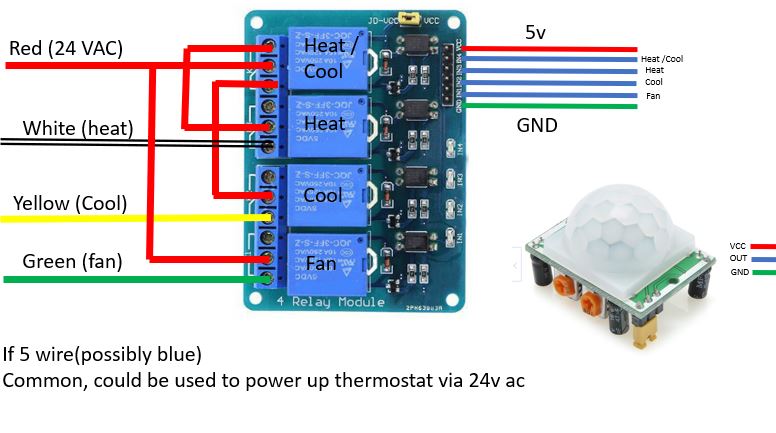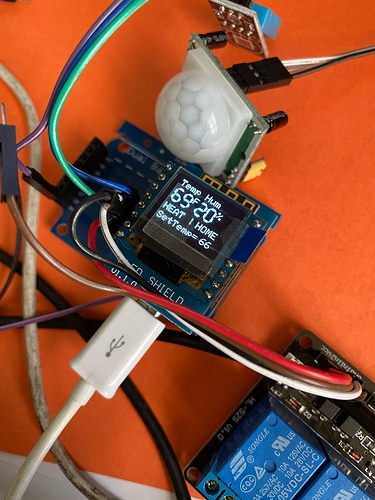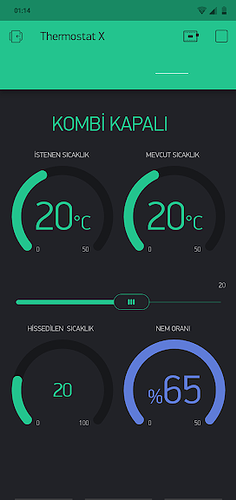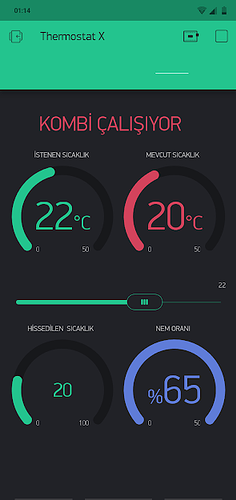For this the wemos mini D1 has enough pins to control 4 relays and PIR motion, DHT11 and OLED display
Maybe.
But, I’m not convinced you need the hot/cold relay.
You aren’t planning on having any physical controls buttons the ?
Pete.
I think it may be there to prevent turning both Heat/Cool on at the same time.
Agreed, but only necessary if you don’t trust your programming skills enough to prevent you from activating both the hot and cold relays at the same time ![]()
Pete.
why not use multiple ESP8266 with the same Blynk Auth code? no need for the complications of Blynk bridge.
“I’m sorry Dave, you can’t do that”.
Well, you can, but one should never miss the opportunity to misquote HAL.
If you share Auth codes between devices then things can get very messy. Blynk wants you to have one device per Auth code, and you get some nice benefits in return like on/offline status for each device.
Pete.
@Jas I’m happy to have you adapt the code for your needs, as many already have.
One feature you may have overlooked is that there is already a heating / cooling indicator in the Blynk dashboard. The ‘actual temperature’ gauge turns red or blue to indicate when heat or AC is running, respectively. Green shows the system is at rest. Maybe you’d like to add a 4th color for fan only.
ThermoX is now on GitHub!
Yes, I’ve finally done this the right way, and will stop posting full code updates here in the forum. For anyone interested, here’s the link:
Enjoy!
but don’t we need one Auth code per project?
and aren’t we limited to only 10 projects in the Blynk app? or can we change this in local server?
Hi Dave!
You can modify the server.properties file and increase the number of dashboards at local server according your needs. No limits!
Regards
TY, i had a hunch ![]()
but yeah, been using multiple ESP8266’s with single auth codes for years, you only need to keep track of the Vx’s and its not messy at all. i guess i recall one bad experience with Bridge and have disregarded it ever since?
you can also use analog or I2C multiplexers to vastly expand the number of sensors attached to a single ESP8266 (i am using this in my gardening array)
I am still waiting on a few shields to come in to clean up some wiring and a bit more of the sketch to edit.
Thanks for creating the GitHub!
Thank you very much. Excellent. An important resource for everyone. I am grateful for sharing. I’ve made many additions to your code, if I may. I’ve added an oled 126x64 screen. I added Real Time Clock. and I plan to add Weekly and Daily schedules. I share codes here. I’m waiting for your advice to me. Here Video Here
Termostat X HVAC
/****************************************************************************
* ThermoX v0.30.0 HVAC Thermostat
*
* Compares ambient and desired temperatures, and runs heat or A/C as needed.
* Hysteresis levels for both Summer and Winter are independently adjustable.
* Sensor can be corrected +/- 5 degrees. All user preferences are saved, and
* reloaded on startup.
*
* HOME setting can be triggered in IFTTT by your cell phone location channel,
* causing an action on the Webhooks channel. Webhooks parameters are as follows:
* URL: http://blynk-cloud.com:8080/YOUR_TOKEN/pin/V31
* Method: PUT
* Content Type: application/json
* Body: ["1"]
* Make an identical IFTTT recipe for AWAY but use ["0"] for the body parmeter.
*
* Color coded DESIRED TEMPERATURE widget: red/blue/green for heat/cool/off
* modes, respectively.
*
* PERCEIVED TEMPERATURE mode augments actual temperature when Summer humidity is high.
*
* Added 15 minutes ON "pulse" mode.
*
* New minimum and maximum temperature settings override "away" mode (my plants were
* dying). Now, even in AWAY mode, HVAC will come on if min/max limits are exceded.
*
* Added native Alexa control (HUE emulation).
* - "Turn ON" activates deactivates system halt, and runs pulse mode.
* - "Turn OFF" activates cancels pulse, or activates system halt if no pulse was running.
* - "Turn UP/DOWN" chages temperature 2 degrees.
* - "Set ThermoX to ##" sets a new desired temperature
*
* An independent "Alexa, set temperature to ##" changes desired temperature setting.
*
* Automatically reconnects to last working wifi. If unavailable, it creates an access
* point ("ThermoX") to which you can connect and share locl wifi credentials.
*
* Use any ESP8266, a relay on GPIO 0, and DHT11 temperature sensor on GPIO 2.
* OTA updates are only possible on devices with >512K memory.
*
* Oled
*****************************************************************************
*/
#include <ESP8266WiFi.h> //https://github.com/esp8266/Arduino
#include <ESP8266WebServer.h>
#include <DNSServer.h>
#include <Wire.h> // must be included here so that Arduino library object file references work
#include <RtcDS1307.h>
RtcDS1307<TwoWire> Rtc(Wire);
#include <OLED_I2C.h>
OLED myOLED(SDA, SCL); // Remember to add the RESET pin if your display requires it... NodeMCU Board (D2,D1 ) Pin
extern uint8_t logo[];
#include <BlynkSimpleEsp8266.h> //https://github.com/blynkkk/blynk-library
#include <WiFiManager.h> //https://github.com/tzapu/WiFiManager
#include <WiFiUdp.h>
#include <EEPROM.h>
#include <ArduinoOTA.h>
#include <Espalexa.h> //https://github.com/Aircoookie/Espalexa
#include <Adafruit_GFX.h>
#include <Adafruit_SSD1306.h>
#include "DHT.h" //https://github.com/adafruit/DHT-sensor-library
#define DHTPIN 14 // Digital pin connected to the DHT sensor Node MCU D5
#define DHTTYPE DHT11 // DHT 11
//#define DHTTYPE DHT22 // DHT 22 (AM2302)
//#define DHTTYPE DHT21 // DHT 21 (AM2301)
#define UpdateFrequency 8000 //How often a new temperature will be read
#define MenuTimeOut 10000 //Menu timeout from inactivity
#define LongPress 300 //How long SETTINGS button needs to be pressed to enter menu
#define RelayPin 0 // Arduino Wemos D1 (D8 pin ) NodeMcu (D3 Pin)
#define OFF 0 // These just make the code easier to read
#define ON 1
#define OLED_RESET 0 // GPIO0
Adafruit_SSD1306 display(OLED_RESET);
//WiFi and Blynk connection variables
String myHostname = "KombiX";
char auth[] = "YourAuthToken"; // Blynk token "YourAuthToken"
//Set up as a native Alexa device (Hue emulation)
char Device1[] = "ThermoX"; // ON/OFF switch name in the Alexa app
EspalexaDevice* espalexaPointer;
Espalexa espalexa;
// Blynk color palette
const String BLYNK_BLUE = "#04C0F8";
const String BLYNK_RED = "#D3435C";
const String BLYNK_GREEN = "#23C48E";
String TARIH;
String SAAT;
const long interval = 1000;
unsigned long previousMillis = 0;
unsigned long TpreviousMillis = 0;
const long Tkesme = 2500;
unsigned long Tonceki = 0;
unsigned long eskiZaman=0;
unsigned long yeniZaman;
unsigned long eskiZaman1=0;
unsigned long yeniZaman1;
// Timer for temperature updates
BlynkTimer timer;
//Thermostat variables
int TempDes = 21; //Desired temperature setting
int PreviousTempDes;
int TempAct = 21; //Actual temperature, as measured by the DHT11 sensor
int BadRead = 0; //Counts consecutive failed readings of the DHT11 sensor
float LastRead = 21; // Previous temperature reading
int Humidity = 10;
int TempMin = 10; // Minimum allowable temperature, even if in "away" mode
int TempMax = 32; // Maximum allowable temperature, even if in "away" mode
// Preference variables
int Hysteresis_W = 2; //Summer and Winter hysteresis levels
int Hysteresis_S = 2;
int TempCorrection = 0; //Used to adjust readings, if the sensor needs calibration
boolean UsePerceivedTemp = false; // Use humidity-adjusted perceived temperature, instead of actual temperature
long PulseTime = 15 * 60 * 1000; // Amount of time for a "pulse" manual run of the system (15 minutes)
// Current condition variables
boolean Winter = true;
boolean Home = true;
boolean ManualRun = false; // used to run fan, overriding thermostat algorithm
boolean ManualStop = false; // used to stop fan, overriding thermostat algorithm
int MenuItem = 0; // Settings menu selection variable
boolean ButtonPressed = false;// Settings button state
boolean LongHold = false; // Flag showoing a long hold detected on the SETTINGS button
int ButtonTimer; // Timer for detecting long press of Settings button
String Response = ""; // Text output to SETTINGS value widget
boolean FanState = OFF; // Is the fan on or off?
int MenuTimer; // Timer for resetting SETTINGS menu after a timeout has elapsed
#define countof(a) (sizeof(a) / sizeof(a[0]))
DHT dht(DHTPIN, DHTTYPE);
void setup() {
//Initialize the fan relay. Mine is "off" when the relay is set HIGH.
pinMode(RelayPin,OUTPUT);
digitalWrite(RelayPin,HIGH);
Rtc.Begin();
RtcDateTime compiled = RtcDateTime(__DATE__, __TIME__);
printDateTime(compiled);
RtcDateTime now = Rtc.GetDateTime();
Serial.println();
display.begin(SSD1306_SWITCHCAPVCC, 0x3C);
// Create an access point if no wifi credentials are stored
WiFi.hostname(myHostname);
WiFiManager wifi;
wifi.autoConnect("ThermoX");
Blynk.config(auth);
dht.begin(); //Start temperature sensor and wait for initialization
delay(1000);
Serial.begin(115200);
//Load any saved settings from the EEPROM
EEPROM.begin(20);
GetPresets();
PreviousTempDes = TempDes;
MenuReset();
ArduinoOTA.begin();
// Espalexa initialization. Parameters: (device name, callback function, device type, initial value)
espalexaPointer = new EspalexaDevice(Device1, AlexaCommands, EspalexaDeviceType::dimmable, TempDes * 2.55);
espalexa.addDevice(espalexaPointer);
espalexa.begin();
timer.setInterval(UpdateFrequency, TempUpdate); // Update temp reading and relay state
timer.setInterval(30000L, OtherUpdates); // Refreshes non-urgent dashboard info
}
void loop() {
// int okunan_deger = DHT11_Sensorum.read(DHT11_pini);
// DHT Temp and Hum Terminal Print
//read temperature and humidity
float t = dht.readTemperature();
float h = dht.readHumidity();
if (isnan(h) || isnan(t)) {
Serial.println("Nem Is? Sens?r? Okunamad?");
}
myOLED.rotateDisplay(true);
RtcDateTime now = Rtc.GetDateTime();
printDateTime(now);
Tarihi();
istenendurum();
isinemyaz();
// delay(200);
Blynk.run();
timer.run();
ArduinoOTA.handle();
espalexa.loop();
}
//*********************** Thermostat Functions **********************************
// This is the decision algorithm for turning the HVAC on and off
void TempUpdate (){
// float ReadF = dht.readTemperature(true); //Get a new reading from the temp sensor
int ReadF = dht.readTemperature() ;
if (isnan(ReadF)) {
BadRead++;
return;
}
// Use perceived temperature instead of actual temperature for Summer cooling
if(UsePerceivedTemp == true && !Winter && ReadF > 21){
// Because perceived temp swings can be large, augment by only a fraction of
// a degree per read. Changes are slowed, and more samples inform the average.
if(ReadF > LastRead + 0.5){
ReadF = LastRead + 0.5;
}
else if(ReadF < LastRead - 0.5){
ReadF = LastRead - 0.5;
}
// Simplified "feels like" temperature formula
ReadF = ((Humidity * .02 * (ReadF - 21)) + ReadF);
}
//To compensate for the DH11's inaccuracy, the temperature is averaged
//withprevious read, and any change is limited to 1 degree at a time.
int TempAvg = int((ReadF + LastRead + (2 * TempCorrection))/2);
if (TempAvg > TempAct){
TempAct += 1;
}
else if (TempAvg < TempAct){
TempAct -= 1;
}
LastRead = ReadF;
BadRead = 0; // Reset counter for failed sensor reads
//************Display OLED ( Ekrana Yaz..)
// display.begin(SSD1306_SWITCHCAPVCC, 0x3C); // Logo adafruit
// display.display();
// delay(2000);
Blynk.virtualWrite(V0,TempAct); //Report the corrected temperature in app
Blynk.virtualWrite(V30,(int(dht.readHumidity()))); //Report the corrected temperature in app
// Decision algorithm for running HVAC
if (!ManualRun && !ManualStop){ // Make sure it's not in one of the manual modes
// If I'm home, run the algorithm
if (Home){
if (Winter){
//If I'm home, it's Winter, and the temp is too low, turn the relay ON
if (TempAct < TempDes){
Fan(ON);
}
//Turn it off when the space is heated to the desired temp + a few degrees
else if (TempAct >= (TempDes + Hysteresis_W)) {
Fan(OFF);
}
}
else if (!Winter){
//If I'm home, it's Summer, and the temp is too high, turn the relay ON
if (TempAct > TempDes){
Fan(ON);
}
//Turn it off when the space is cooled to the desired temp - a few degrees
else if (TempAct <= (TempDes - Hysteresis_S)){
Fan(OFF);
}
}
}
// If I'm not home...
else {
// Turn on the HVAC if the temperature outside of seasonal the minimum / maximum limits
if((Winter && TempAct < TempMin) || (!Winter && TempAct > TempMax)){
Fan(ON);
}
// Otherwise, turn it off
else{
Fan(OFF);
}
}
}
}
void printDateTime(const RtcDateTime& dt)
{
char datestring[11];
snprintf_P(datestring,
countof(datestring),
PSTR("%02u/%02u/%04u"),
dt.Day(),
dt.Month(),
dt.Year());
Serial.println(datestring);
char timestring[9];
snprintf_P(timestring,
countof(timestring),
PSTR("%02u:%02u:%02u"),
dt.Hour(),
dt.Minute(),
dt.Second());
Serial.println(timestring);
TARIH = datestring ;
SAAT = timestring;
}
void istenendurum()
{
yeniZaman = millis();
if(yeniZaman-eskiZaman > 3500){
eskiZaman = yeniZaman;
display.clearDisplay();
display.setTextColor(WHITE);
display.setTextSize(1);
display.setCursor(0, 1);
display.println("ISTENEN :");
display.println(" ");
display.setTextSize(2);
display.print(TempDes) ;
display.print(" ");
display.print("Derece");
display.setTextSize(1);
display.setCursor(1, 35);
display.setTextSize(1);
display.println("MEVCUT:");
// display.println(" ");
display.setTextSize(2);
display.print(int(dht.readTemperature()));
display.print(" ");
display.print("Derece");
myOLED.drawBitmap(0, 16, logo, 48, 48);
myOLED.update();
display.display();
Serial.print("Nem (%): ");
Serial.println(dht.readHumidity());
Serial.print("Sicaklik : ");
Serial.print(dht.readTemperature());
Serial.println(" Derece ");
//delay(4000);
}
}
void isinemyaz()
{
yeniZaman1 = millis();
if(yeniZaman1-eskiZaman1 > 6500){
eskiZaman1 = yeniZaman1;
// display temperature
display.clearDisplay();
display.setTextSize(1);
display.setCursor(0,0);
display.print("SICAKLIK: ");
display.setTextSize(2);
display.setCursor(0,10);
display.print(dht.readTemperature());
display.print(" ");
display.setTextSize(1);
display.cp437(true);
display.write(167);
display.setTextSize(2);
display.print("C ");
// display humidity
display.setTextSize(1);
display.setCursor(0, 35);
display.print("NEM ORANI: ");
display.setTextSize(2);
display.setCursor(0, 45);
display.print(dht.readHumidity());
display.print(" %");
display.display();
}
}
void Tarihi()
{
unsigned long Tsayac = millis(); // if d?ng?s? ile 2 saniye bekliyoruz. 2 saniyede bir veriler ekrana yazd?r?lacak.
if (Tsayac - Tonceki >= Tkesme) {
Tonceki = Tsayac;
Serial.println(TARIH); // Serial Print
Serial.println(SAAT);
display.clearDisplay(); // Oled I2C 128x64 Display
display.setTextSize(2);
display.setCursor(0, 0);
display.println(TARIH);
display.setCursor(15, 18);
display.println(SAAT);
display.setCursor(23, 40);
display.setTextSize(1);
display.println("basersoft.com" );
display.setCursor(25, 55);
display.println("Adullah BASER" );
display.display();
//delay(2000);
}
}
// Turn the HVAC ON or OFF
void Fan(boolean RunFan){
FanState = RunFan;
// Set the proper color for the Desired Temp gauge and ON/OFF LED
//(red = heating, blue = cooling, fan off = normal widget color
if (Winter && FanState){
Blynk.setProperty(V0, "color", BLYNK_RED);
Blynk.setProperty(V32, "color", BLYNK_RED);
Blynk.virtualWrite(V32, "KOMB? ?ALI?IYOR"); // BLYNK App Display Role Value
display.clearDisplay();
display.setTextSize(3);
display.setTextColor(WHITE);
display.setCursor(18, 1);
display.println("KOMBI");
display.setCursor(23, 30);
display.println("ACIK");
display.display();
//delay(200);
}
else if (!Winter && FanState){
Blynk.setProperty(V0, "color", BLYNK_BLUE);
Blynk.setProperty(V32, "color", BLYNK_BLUE);
Blynk.virtualWrite(V32, "KIL?MALAR A?ILDI"); // BLYNK App Display Role Value
display.clearDisplay();
display.setTextSize(3);
display.setTextColor(WHITE);
display.setCursor(10, 1);
display.println("EVDEN");
display.setCursor(5, 26);
display.println("UZAKTA");
display.display();
//delay(200);
}
else{
// Return widgets to their "off" state color, depending on theme
Blynk.setProperty(V0, "color", BLYNK_GREEN);
Blynk.setProperty(V32, "color", BLYNK_GREEN);
Blynk.virtualWrite(V32, " KOMB? KAPALI"); // BLYNK App Display Role Value
display.clearDisplay();
display.setTextSize(3);
display.setTextColor(WHITE);
display.setCursor(14, 1);
display.println("KOMBI");
display.setCursor(8, 28);
display.println("KAPALI"); // Off Value
display.display();
}
digitalWrite(RelayPin,!FanState); // Relay turns fan on with LOW input, off with HIGH
}
// Ends manual pulse mode
void KillManual(){
Fan(OFF);
ManualRun = false;
}
//Temperature slider. Make the desired temperature gauge in Blynk reflect slider changes.
BLYNK_WRITE(V3){
TempDes = param.asInt();
Blynk.virtualWrite(V1,TempDes);
ManualStop = false; //New temperature setting ends any manual stop
if(espalexaPointer != nullptr){ //Update espalexa "brightness" value
espalexaPointer->setPercent(TempDes);
}
}
// Updates dashboard information on the Blynk app
void OtherUpdates(){
Blynk.virtualWrite(V29,Home * 1023); // Update "home" LED on dashboard
Blynk.virtualWrite(V1,TempDes); //Update desired temp on the dashboard
// Notify when the temperature sensor fails repeatedly, and turn off the fan.
if(MenuItem == 0 && !ButtonPressed){
if (BadRead > 10){
Blynk.virtualWrite(V10, String("<<< SENSOR MALFUNCTION >>>"));
BadRead = 0;
if (!ManualRun){ //Manual mode supersedes a malfunction condition
Fan(OFF);
}
}
// Clear notification when sensor reads correctly again
else{
MenuReset();
}
}
if (TempDes != PreviousTempDes){ //update the EEPROM if desired temperature had changed.
EEPROM.write(3,TempDes);
EEPROM.commit();
PreviousTempDes = TempDes;
}
// To stabilize perceived temperature calculation, only update humidity readings between fan cycles
if(FanState == OFF){
// float ReadH = dht.readHumidity(); // Read humidity (percent)
float ReadH =dht.readTemperature();
// Only update hmidity if it's a good read from the sensor. To mitigate any
// instability, average with previous reading, change by only 1% per reading
if(!(isnan(ReadH))){
int HumidityAvg = (ReadH + Humidity) / 2;
if (HumidityAvg > Humidity){
Humidity += 1;
}
if (HumidityAvg < Humidity){
Humidity -=1;
}
}
Blynk.virtualWrite(V2, Humidity);
}
}
//************************ External Changes (Alexa, IFTTT) ************************************
// Alexa native device (shows up in Alexa app as a Hue device)
void AlexaCommands(EspalexaDevice* espalexaPointer) {
if(espalexaPointer == nullptr) return;
//Retrieve numeric value, and show in Blynk settings tab
int AlexaPercent = espalexaPointer->getPercent();
Response = "Alexa temp: ";
Response += AlexaPercent;
Blynk.virtualWrite(V10,Response);
MenuTimer = timer.setTimeout(MenuTimeOut, MenuReset);
// "Alexa, Turn OFF" ends manual run, or applies Manual stop if not running
if(AlexaPercent == OFF){
Fan(OFF);
if(ManualRun){
ManualRun = false;
}
else{
ManualStop = true;
}
}
// "Alexa, turn ON," set level (temperature), or augment
else{
// If the fan is already ON, use imcomming level for temperature setting
if(FanState == ON){
//"Alexa, turn UP..." triggers an unusually big change. Incremnent 2 degrees.
if(AlexaPercent > TempDes + 10){
TempDes += 2;
}
//"Alexa, turn DOWN..." triggers an unusually big change. Decrement 2 degrees.
else if(AlexaPercent < TempDes - 10){
TempDes -= 2;
}
//"Alexa, set ThermoX to ##" triggers a reasonable change. Use as desired temperature.
else if(AlexaPercent >= TempMin && AlexaPercent <= TempMax){
TempDes = AlexaPercent;
}
Blynk.virtualWrite(V1, TempDes);
Blynk.virtualWrite(V3, TempDes);
if(espalexaPointer != nullptr){ //Update espalexa "brightness" value
espalexaPointer->setPercent(TempDes);
}
}
// Otherwise, it was a "Turn ON" command, so run a pulse cycle
else{
ManualRun = true;
Fan(ON);
timer.setTimeout(PulseTime, KillManual);
}
}
}
//Get location (home or away) from the IFTTT iOS location and Maker channels
BLYNK_WRITE(V31)
{
Home = param.asInt();
if (Home){ //Turn the HOME LED widget on or off
Blynk.virtualWrite(V29,1023);
}
else Blynk.virtualWrite(V29,0);
}
//************************** Settings Menu Functions *******************************
// Dashboard SETTINGS button. Press-and-hold to enter menu. Short press for next item.
BLYNK_WRITE(V4) {
// When the SETTINGS button is pressed, start a timer to check for a long press
if(param.asInt()){
ButtonTimer = timer.setTimeout(300, LongHoldDetect);
ButtonPressed = true;
}
// Button has been released
else {
timer.deleteTimer(ButtonTimer); // Kill current long button hold detection
ButtonPressed = false; // Reset the button press flag
// If the long hold function wasn't just called, it's a short press. Avance the menu.
if (!LongHold && MenuItem != 0){
NextMenuItem(); // Advance to next menu item
}
// Reset the long press flag
LongHold = false;
}
}
// Checks for long press condition on SETTINGS button
void LongHoldDetect(){
// If the button is still depressed, it's a long hold
if (ButtonPressed && LongHold == false){
// Enter or exit the SETTINGS menu, if it was a long press
LongHold = true; // Flag prevents repeated tripping of long hold
if (MenuItem == 0){
MenuTimer = timer.setTimeout(MenuTimeOut, MenuReset);
NextMenuItem(); // Enter the SETTINGS menu
}
else{
MenuReset(); // Exit the SETTINGS menu
}
}
}
//Cycles through the Settings Menu in the Labeled Value widget
void NextMenuItem(){
timer.restartTimer(MenuTimer);
MenuItem += 1;
if (MenuItem > 8){
MenuItem = 1;
}
switch(MenuItem){
case 1:
if (ManualRun){
Response = "CANCEL PULSE?";
}
else{
Response = "15 MIN PULSE?";
}
break;
case 2:
if (UsePerceivedTemp){
Response = "USE ACTUAL TEMP?";
}
else Response = "USE PERCEIVED TEMP?";
break;
case 3:
if (ManualStop){
Response = "END SYSTEM HALT?";
}
else{
Response = "HALT SYSTEM?";
}
break;
case 4:
if (Home){
Response = "LOCATION: HOME";
}
else Response = "LOCATION: AWAY";
break;
case 5:
if (Winter){
Response = "MODE : WINTER";
}
else Response = "MODE : SUMMER";
break;
case 6:
if (Winter){
Response = "HYSTERESIS: ";
Response += Hysteresis_W;
Response += " DEG";
}
else{
Response = "HYSTERESIS: ";
Response += Hysteresis_S;
Response += " DEG";
}
break;
case 7:
Response = "TEMP CORRECTION: ";
Response += TempCorrection;
Response += " DEGREES";
break;
case 8:
if(Winter){
if(TempMin < 10 || TempMin > 32){
Response = "SET MINIMUM TEMP?";
}
else{
Response = "MINIMUM TEMP: ";
Response += TempMin;
}
}
else{
if(TempMin < 10 || TempMin > 32){
Response = "SET MAXIMUM TEMP?";
}
else{
Response = "MAXIMUM TEMP: ";
Response += TempMax;
}
}
break;
}
Blynk.virtualWrite(V10,Response);
}
//Dashboard MODIFY button. Executes change of selected menu item
BLYNK_WRITE(V5){
if (MenuItem > 0 && param.asInt()){
timer.restartTimer(MenuTimer);
switch(MenuItem){
//Forced 15 minute run
case 1:
if (ManualRun){
ManualRun = false;
Response = "15 MIN PULSE?";
}
else{
ManualRun = true;
ManualStop = false;
Fan(ON);
Response = "PULSE: ON";
timer.setTimeout(PulseTime, KillManual);
}
break;
//User perceived temperature instead of actual
case 2:
if (UsePerceivedTemp){
Response = "ACTUAL TEMP MODE";
UsePerceivedTemp = false;
EEPROM.write(5,0);
}
else {
Response = "PERCEIVED TEMP MODE";
UsePerceivedTemp = true;
EEPROM.write(5,1);
}
if(UsePerceivedTemp){
Blynk.setProperty(V0, "label", " Perceived Temperature");
}
else{
Blynk.setProperty(V0, "label", " Actual Temperature");
}
break;
//Turn system off
case 3:
if (ManualStop){
ManualStop = false;
Response = "HALT SYSTEM?";
}
else {
ManualStop = true;
ManualRun = false;
Fan(0);
Response = "SYSTEM HALTED";
}
break;
//Change location manually
case 4:
if (Home){
Home = false;
Response = "LOCATION : AWAY";
}
else {
Home = true;
Response = "LOCATION : HOME";
}
break;
//Change season
case 5:
if (Winter){
Response = "MODE : SUMMER";
Winter = false;
EEPROM.write(4,0);
}
else {
Response = "MODE : WINTER";
Winter = true;
EEPROM.write(4,1);
}
break;
//Change hysteresis level of currently selected season
case 6:
if (Winter){
Hysteresis_W += 1;
if (Hysteresis_W > 6){
Hysteresis_W = 1;
}
EEPROM.write(1,(Hysteresis_W));
Response = "WINTER HYSTERESIS: ";
Response += Hysteresis_W;
Response += " DEG";
}
else{
Hysteresis_S += 1;
if (Hysteresis_S > 6){
Hysteresis_S = 1;
}
EEPROM.write(2,(Hysteresis_S));
Response = "YAZ HYSTERESIS: ";
Response += Hysteresis_S;
Response += " DEG";
}
break;
// Correct faulty DHT11 readings
case 7:
TempCorrection +=1;
if (TempCorrection > 5){
TempCorrection = -5;
}
EEPROM.write(0, TempCorrection);
Response = "TEMP CORRECTION: ";
Response += TempCorrection;
Response += " DEG";
break;
//Change minimum Winter temperature or maximum Summer temperature
case 8:
if(Winter){ // Winter minimum temperature
TempMin += 2;
if(TempMin > 68){
TempMin = 10;
}
Response = "MINIMUM TEMP: ";
Response += TempMin;
EEPROM.write(7,(TempMin));
}
else{ // Summer maximum temperature
TempMin += 2;
if(TempMax > 32){
TempMax = 78;
}
Response = "MAXIMUM TEMP: ";
Response += TempMax;
EEPROM.write(8,(TempMax));
}
}
EEPROM.commit();
Blynk.virtualWrite(V10, Response);
}
}
// Reset the Menu at startup or after timing out from inactivity
void MenuReset(){
MenuItem = 0;
Blynk.virtualWrite(V10, String("HOLD 2 SEC FOR MENU"));
}
//**************************** Miscellaneous *********************************
//Retrieves saved values from EEPROM
void GetPresets(){
TempCorrection = EEPROM.read(0);
if ((TempCorrection < -5) || (TempCorrection > 5)){
TempCorrection = 0;
EEPROM.write(0, 0);
}
UsePerceivedTemp = EEPROM.read(5);
if(UsePerceivedTemp){
Blynk.setProperty(V0, "label", " Perceived Temperature");
}
else{
Blynk.setProperty(V0, "label", " Actual Temperature");
}
Winter = EEPROM.read(4);
Hysteresis_W = EEPROM.read(1);
Hysteresis_S = EEPROM.read(2);
if (!(Hysteresis_W >= 1) && !(Hysteresis_W <= 6)){
Hysteresis_W = 2;
EEPROM.write(1, Hysteresis_W);
}
if (!(Hysteresis_W >= 1) && !(Hysteresis_W <= 6)){
Hysteresis_S = 2;
EEPROM.write(2, Hysteresis_S);
}
TempDes = EEPROM.read(3);
if (!(TempDes >= 10) && !(TempDes <= 32)){
TempDes = 21;
EEPROM.write(3, 21);
}
if(espalexaPointer != nullptr){
espalexaPointer->setPercent(TempDes);
}
TempMin = EEPROM.read(7);
if(!(TempMin >= 10 && TempMin <= 32)){
TempMin = 10;
EEPROM.write(7, TempMin);
}
TempMax = EEPROM.read(8);
if(!(TempMax >= 10 && TempMax <= 32)){
TempMax = 32;
EEPROM.write(8, TempMax);
}
EEPROM.commit();
}
> Blockquote
``@baser please edit your post, using the pencil icon at the bottom, and add triple backticks at the beginning and end of your code so that it displays correctly.
Triple backticks look like this:
```
Pete.
Thank you. I finally found it.
Just curious if users outside of North America are able to use the Alexa commands.
Ok Google Works Perfectly in Turkish Language. I didn’t try Alexsa.
Can I share the project in Github with your permission?
Sure, but just make a fork of the original Github code.



